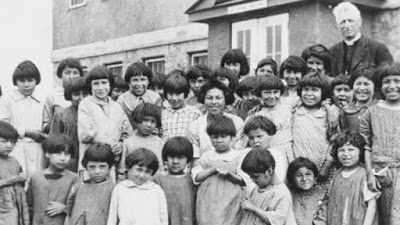Child-separation: an ugly Canadian tradition
 |
| Canadian Dimension – SEPTEMBER 4, 2018 |
“Obviously, this is not the way we do things in Canada,” Prime Minister Justin Trudeau said to reporters on June 20, responding to the anguish and outrage sparked by U.S. President Donald Trump’s widely condemned and subsequently abandoned “zero tolerance” policy on illegal entry to the United States, which involved forcibly separating migrant children from their parents.
Trudeau’s words would be laughable if the reality weren’t so cruel. Child separation policies and practices in Canada are as old as the nation-state itself (and have their roots in the pre-Confederation colonial period).
The Indian Act of 1876 laid the groundwork for the first homegrown Canadian child-separation policy, which was introduced as an amendment to the Act in 1884 to the effect that: “The Governor in Council may make regulations, which shall have the force of law, for the committal by justices or Indian agents of children of Indian blood under the age of sixteen years, to such industrial school or boarding school, there to be kept, cared for and educated for a period not extending beyond the time at which such children shall reach the age of eighteen years.” This was the official basis of the infamous residential school system, the mission of which was to separate the children from their parents on reserves and confine them in church-run schools in an effort to assimilate them into Euro-Canadian culture. In all, some 150,000 children were separated from their families between 1876 and 1996, 6,000 of whom died or disappeared, although precise numbers are hard to determine because those in charge of the schools conveniently failed to keep accurate records.
Canada has continued its child-separation practices through its child-protection services and criminal justice institutions.
Indigenous children make up more than 50 per cent of all children under the age of five in foster care, yet only eight per cent of Canada’s population aged four and under are Indigenous. This trend is reflected in the criminal-justice system as well. According to Statistics Canada, in 2016-2017 fully 46 per cent of the youths held in Canada’s criminal justice institutions were Indigenous, while Indigenous youths make up only eight per cent of Canada’s total youth population. There are of course notable regional disparities: Saskatchewan’s rate of Indigenous youth incarceration is the highest in the country at 92 per cent for boys and 98 per cent for girls; Manitoba ranks second with a rate of 81 per cent for boys and 82 per cent for girls. For years now, criminologists and other observers have aptly referred to Canada’s prisons as the new residential schools.
The Canadian state’s cruelty to children is not limited to Indigenous families. Consider, for example, the uptick in the detention of migrant families and the deportation of parents whose children are Canadian as observed by watchdogs such as the End Immigration Detention Network (EIDN). When entire families are placed in detention, children are separated from their fathers as they are usually held in women’s holding centres, or families have the option to place their children in foster care. Last year, according to EIDN, 162 children were detained in Canada. According to a report by the International Human Rights Program of the Faculty of Law at the University of Toronto, studies show that detained children experience “high rates of psychiatric symptoms, including self-harm, suicidality, severe depression, regression of milestones, physical health problems, and post-traumatic presentations” while younger children also suffer from “developmental delays and regression, separation anxiety and attachment issues, and behavioural changes, such as increased aggressiveness.” With rates of asylum-seeking rising steadily, the numbers of child victims will only grow as long as the focus remains on border protection.
Alternatives to incarceration must be found both for the still relatively small numbers of migrant families detained in Canada and the disproportionately high numbers of Indigenous youths populating Canadian prisons. In the latter case it is well worth investing in and expanding recourse to restorative justice programs, aimed precisely at reintegrating offenders into their communities. Until Canada radically reforms its prison system and ceases to criminalize asylum seekers, our smug responses to the egregious actions of the United States are unwarranted.


